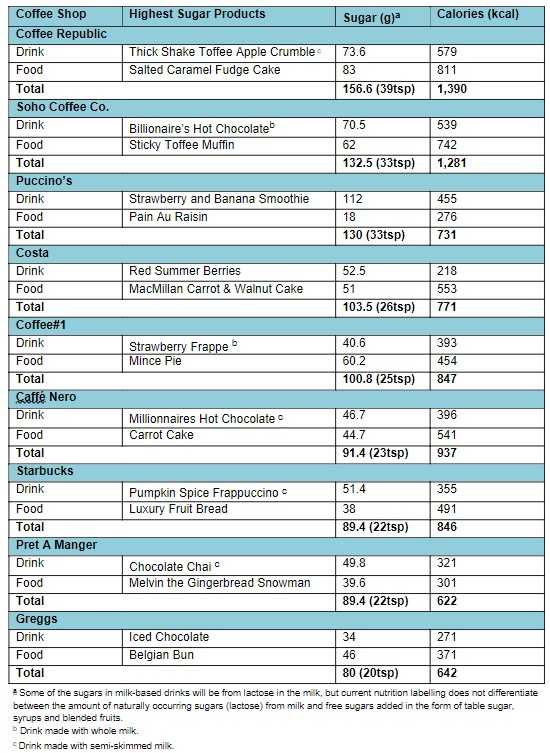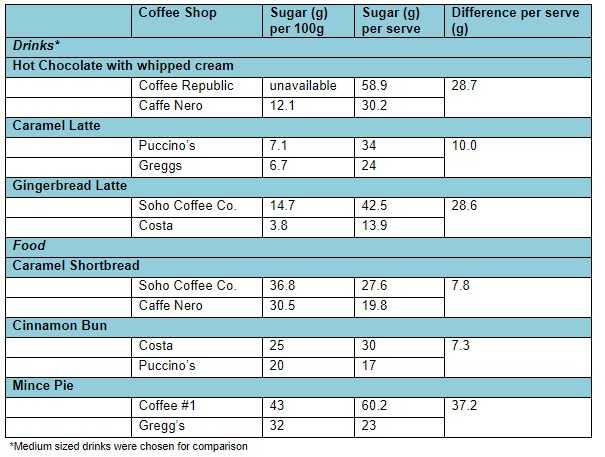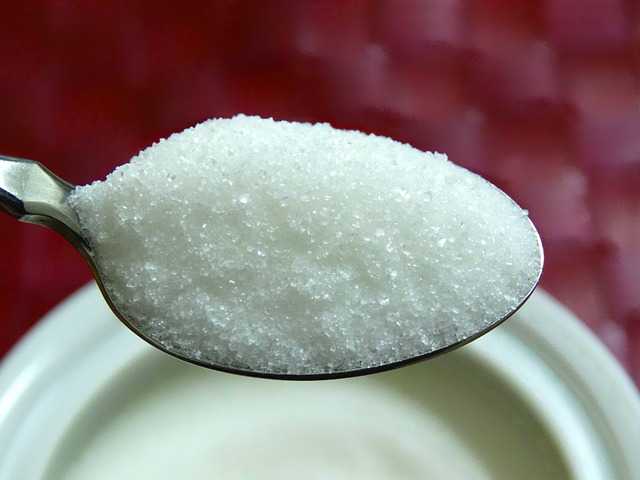LONDON, UK – To mark Sugar Awareness Week (13th-19th November), a new product survey by Action on Sugar, based at Queen Mary University of London [2], has revealed over a third of sweet food and drink products sold in major high street coffee shops exceed an adult’s daily limit of sugar (30g for free sugars) in just one serve [3] – with one food and drink combination containing a staggering 157g (39 tsp) of sugar! See Table 1.
With more than one in two young adults aged 25-34 living with overweight and obesity [4] and one in three adults aged 25-34 years [5] suffering from untreated tooth decay in the UK, Action on Sugar is calling for greater transparency over a ‘scandalous’ lack of nutrition information available at point of purchase and new levies to be introduced to encourage healthier food and drink across the board.
Whilst certain companies are required, by law, to display the calorie content of food and drink at the point of purchase, details about the sugar content are often limited. Today’s research reveals that 782 sweet food and drink products surveyed in nine leading high street coffee shops were often “insufficiently labelled for consumers.
 Over half would be marked ‘red’ (high in total sugars) if nutrition information was fully transparent. Astonishingly, just one food item (a Greggs All Butter Croissant) was low in sugar.
Over half would be marked ‘red’ (high in total sugars) if nutrition information was fully transparent. Astonishingly, just one food item (a Greggs All Butter Croissant) was low in sugar.
To put this into perspective, a visit to a coffee shop could see a person consume up to 39 teaspoons of sugar and a colossal 1,390 calories (equivalent to two and a half ready meal lasagnes [6]) with one of the following food and drink combinations:
Despite the astronomical amount of sugar found in the products surveyed, the difference in sugar content of similar products can vary widely (See Table 2), illustrating the food and drink industry’s ability to reduce sugar if incentivised.
 The new industry levies being proposed by Action on Sugar to encourage reformulation, could include extending the current Soft Drinks Industry Levy (SDIL) across ALL juice and milk-based drinks and introducing levies targeting the high sugar content in sweet foods. Revenue generated from the levy can be invested back into children’s health.
The new industry levies being proposed by Action on Sugar to encourage reformulation, could include extending the current Soft Drinks Industry Levy (SDIL) across ALL juice and milk-based drinks and introducing levies targeting the high sugar content in sweet foods. Revenue generated from the levy can be invested back into children’s health.
Under the recent voluntary measures, the OOH sector has been unsuccessful in reducing sugar – with just a mere 0.2% reduction overall compared to a more impressive 44% decrease in average sugar added to soft drinks (as a result of the SDIL [7]).
Dr Kawther Hashem, Campaign Lead at Action on Sugar says: “The use of levies is an effective lever to encourage companies to reduce sugar and calories in their products. The Soft Drinks Industry Levy is a key example of this which successfully removed a massive 46,000 tonnes of sugar from these drinks as well as raising millions of pounds which has been invested in children’s health. We now need to see similar levies introduced across other categories to shift the market towards a healthier direction.”
Zoe Davies, Nutritionist at Action on Sugar says: “It’s incredible how easy it is to unknowingly consume 39 teaspoons of sugar and over 1,300 calories with a simple drink and cake purchase – all of which is highly unnecessary to taste great. What’s more, it’s unacceptable that consumers are often left in the dark as product information about sugar content is not displayed at the point of sale and online PDF documents are unavailable or difficult to find and understand. This is why clearer labelling should be a must, so people know exactly what they are buying.”
Graham MacGregor, Professor of Cardiovascular Medicine at Queen Mary University of London and Chairman of Action on Sugar says: “Whilst it is scandalous that companies get away with providing so little nutrition information, it is even more outrageous that the government hasn’t taken decisive action to incentivise sugar reduction. The need for mandatory nutrition labelling in the Out of Home sector and the introduction of new levies to encourage reformulation has never been more evident. Without doubt, an unhealthy diet high in saturated fat, salt and sugar, and low in fruit and vegetables, is the biggest cause of death and disability globally and costs the UK alone more than £100 billion annually. It’s time to redefine profit as a healthy population.”
References
[1] Adults should have no more than 30g of free sugars a day, (roughly equivalent to 7 sugar cubes). https://www.nhs.uk/live-well/eat-well/food-types/how-does-sugar-in-our-diet-affect-our-health/#:~:text=This%20means%3A,day%20(5%20sugar%20cubes)
[2] Action on Sugar surveyed 466 open cup drinks and 316 unpackaged sweet foods in coffee shops (782 total), examining their nutrition content. Nutrition information was originally sought in 12 major coffee shops (BB’s Coffee & Muffins, Café Nero, Caffe Ritazza, Coffee#1, Coffee Republic, Costa, Greggs, Muffin Break, Pret A Manger, Puccino’s, Soho Coffee Co. and Starbucks). Data for their Autumn menu range was collected directly from coffee shop websites and downloadable nutrition information documents between August and October. Three coffee shops did not have nutrition information online, and therefore were not included in the survey (BB’s Coffee & Muffins (provided only calorie information), Caffe Ritazza and Muffin Break). Since drinks are often provided with a variety of milk options, for the purposes of this survey, only medium sized drinks were chosen and semi-skimmed milk where available. All collated nutrition information was shared with companies beforehand. In addition, festive seasonal menu items were included on 8th November 2023. Due to time constrains the collated nutrition information for festive drinks was not verified with companies beforehand. Out of 782 products, 294 had a total sugars content of more than 30g per serve (38%).
[3] Some of the sugars in milk-based drinks will be from lactose in the milk, but current nutrition labelling does not differentiate between the amount of naturally occurring sugars (lactose) from milk and free sugars added in the form of table sugar, syrups and blended fruits.
[4] Health Survey for England, 2021.59% of adults aged 25-34 years old are living with overweight and obesity. Overall, adults aged 16-75+ living with overweight and obesity is 65%. https://digital.nhs.uk/data-and-information/publications/statistical/health-survey-for-england/2021/health-survey-for-england-2021-data-tables
[5] Untreated tooth decay was more prevalent in participants aged 25-34 (35.3%) Public Health England. National Dental Epidemiology Programme for England. Oral health survey of adults attending general dental practices 2018. https://assets.publishing.service.gov.uk/media/5ee0abb0d3bf7f1eb9646438/AiP_survey_for_England_2018.pdf
[6] Based on a Tesco Beef Lasagne 400g, 558kcal per pack, https://www.tesco.com/groceries/en-GB/products/310130809
[7] Sugar reduction – industry progress 2015 to 2020. Office for Health Improvement & Disparities. https://assets.publishing.service.gov.uk/government/uploads/system/uploads/attachment_data/file/1121444/Sugar-reduction-and-reformulation-progress-report-2015-to-2020.pdf


















